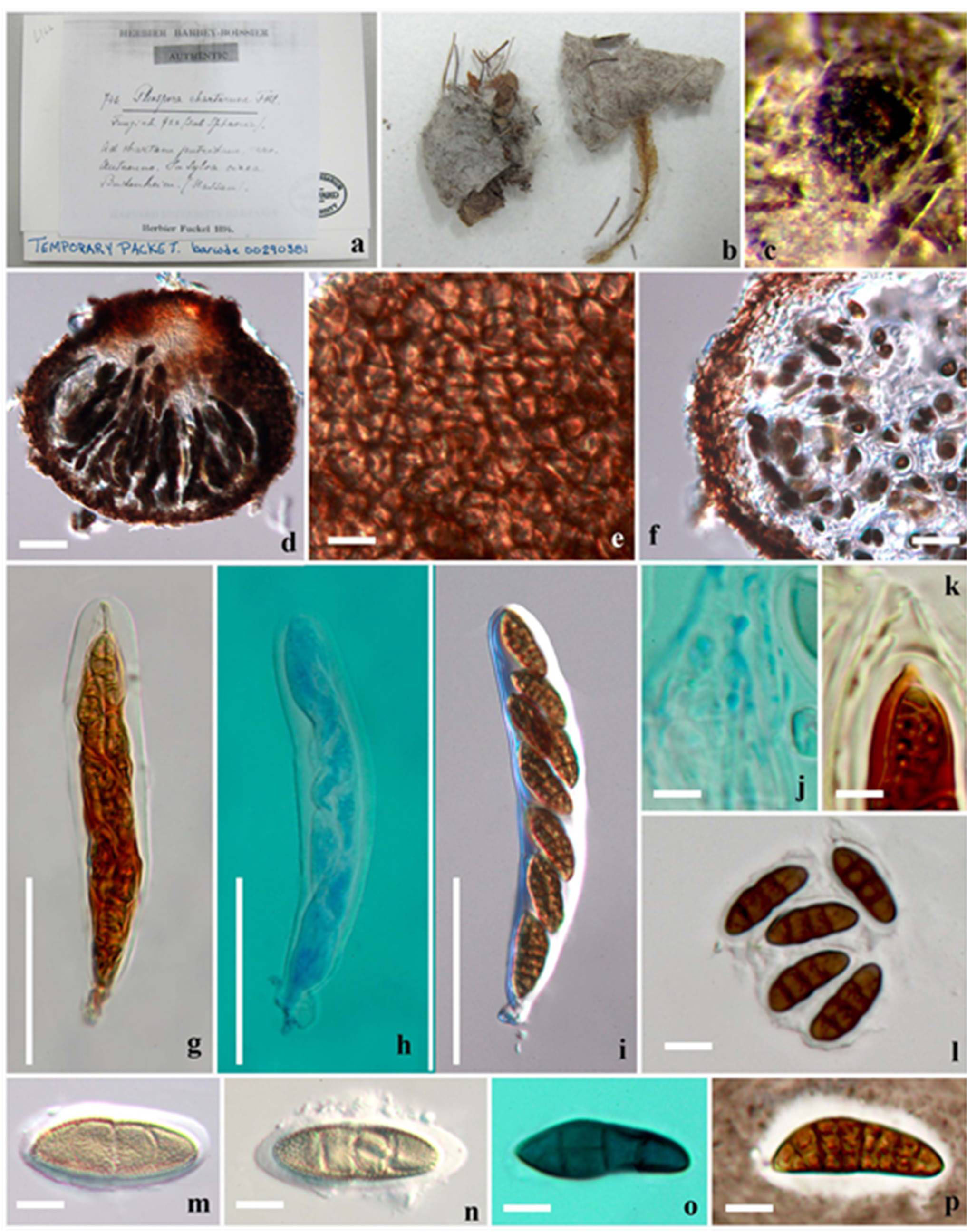Platysporoides chartarum (Fuckel) Shoemaker & C.E. Babc., Can. J. Bot. 70(8): 1650 (1992)
Basionym: Pleospora chartarum Fuckel, Jb. nassau. Ver. Naturk. 23-24: 133 (1870)
≡ Clathrospora chartarum (Fuckel) O.E. Erikss., Arkiv før Botanik 6 (4-5): 352 (1967)
Saprobic in terrestrial habitats. Sexual morph: Ascomata 150–230 μm × 180–260 μm, scattered, immersed, semi-immersed to rarely superficial, globose, subglobose, black, smooth; apex with a protruding papilla, ostiolate. Ostiole comprises of blunt papilla without periphyses. Peridium 8–22 μm wide, composed of 2–4 layers of brown cells of textura angularis, cells 5–9 μm diam., cell wall 1–2.5 μm thick. Hamathecium of 2–3 μm broad, long cellular pseudoparaphyses, anastomosing, septate. Asci 110–140 × 12.5–16.5 μm (= 121:5 × 14:7mm, n=10), (6-)8-spored, bitunicate, fissitunicate, cylindrical to cylindro-clavate, with a short, furcate pedicel, 8–17 μm long,and minute ocular chamber. Ascospores 20–26 × 8–11 μm ( = 23:7 × 9 μm, n=10), obliquely uniseriate and partially overlapping, flattened, broadly ellipsoid in front view, reddish brown, 3 transverse septa, one longitudinal septum in each central cell, 1 oblique septum in each end cell, constricted at all septa, granulate, with a 2–3 μm wide sheath. Asexual morph: unknown.
Material examined: GERMANY, Rhineland-Palatinate, on dead leaves, 1894, Herbier Barby-Boissier (HUH 00290381, holotype).
Notes: Platysporoides was introduced as a subgenus of Pleospora by Wehmeyer (1961) and was typified by Pleospora chartarum. Shoemaker and Babcock (1992) raised Platysporoides to generic rank and placed it in the Pleosporaceae based on its “applanodictyospore” and “terete pored beak of the ascomata”. Currently, eleven species are included in this genus (Shoemaker and Babcock 1992). Another comparable pleosporalean family is Diademaceae, which is distinguished from Platysporoides by its ascoma opening as “an intraepidermal discoid lid” (Shoemaker and Babcock 1992). Aigialus grandis is another pleosporalean fungus with flattened and muriform ascospores as well as papilla and ostioles, which belongs to Aigialaceae, a phylogenetically well supported marine family (Suetrong et al. 2009). Thus, it is highly likely that flattened and muriform ascospores are of little phylogenetic significance.
Currently no molecular data is available for this genus therefore it is essential to epitypify the generic type of this with fresh collections. Therefore molecular data can be used to resolve the correct natural classification of Platysporoides. We tentatively place Platysporoides in Pleosporaceae based on its similarities with the other genera of this family, such as, in having globose to subglobose ascomata with pore-like ostiole, peridium composed of a few layers of textura angularis cells, cellular pseudoparaphyses, fissitunicate, cylindrical to cylindro-clavate asci with broadly ellipsoid, reddish-brown, muriform ascospores.
Fig. 1 Platysporoides chartarum. a-b Specimen and description. c Ascomata on substrate. d Section through ascoma. e Upper walled cells of ascoma. f Peridium. g Ascus when immature in Melzer’s reagent. h Ascus when immature in Cotton Blue reagent. i Ascus at maturity. j Hamathecium in Cotton Blue reagent. k Ocular chamber in Melzer’s reagent. l Ascospores at maturity. m-n Ascospore when immature with Sheath. o Ascospore when immature in Cotton Blue reagent. p Ascospore at maturity with sheath in India Ink. Scale bars: d = 40 μm, e-f = 10 μm, g-i = 100 μm, j = 10 μm, k-p = 5 μm

